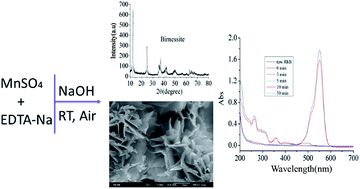A facile one-pot synthesis of three-dimensional microflower birnessite (δ-MnO2) and its efficient oxidative degradation of rhodamine B
Abstract
High purity birnessite (δ-MnO2) was obtained by a facile one-pot method using MnSO4·H2O as a Mn resource, ethylenediamine tetraacetic acid disodium salt (EDTA-Na) as a complexing agent and oxygen in the air as an oxidant under alkaline conditions. The as-prepared birnessite presented three-dimensional microflowers composed of two-dimensional ultrathin nanosheets. Degradation results indicated that the prepared δ-MnO2 possessed excellent abilities for removal of rhodamine B (RhB). Typically, 50 mL of RhB (10 mg L−1) could be degraded completely with a 10 mg sample in 5 min without any additives such as hydrogen peroxide, peroxysulphate or any supplementary means such as microwaves or ultrasound. The samples were characterized by Fourier transform infrared spectroscopy (FTIR), X-ray diffraction (XRD), X-ray photoelectron spectroscopy (XPS), field emission scanning electron microscopy (FESEM), and N2 gas adsorption–desorption and thermogravimetry analysis (TGA) techniques. The mechanism of the degradation process was proposed and it was discussed that a redox reaction between birnessite and RhB occurred in an acidic environment. Clearly, the as-prepared birnessite provides great potential for the rapid degradation of dyes and organic pollutants. As it has easily available starting materials, a simple method for synthesis and undemanding degradation conditions, the as-prepared birnessite has high practical value in treating environmental pollutants.


 Please wait while we load your content...
Please wait while we load your content...